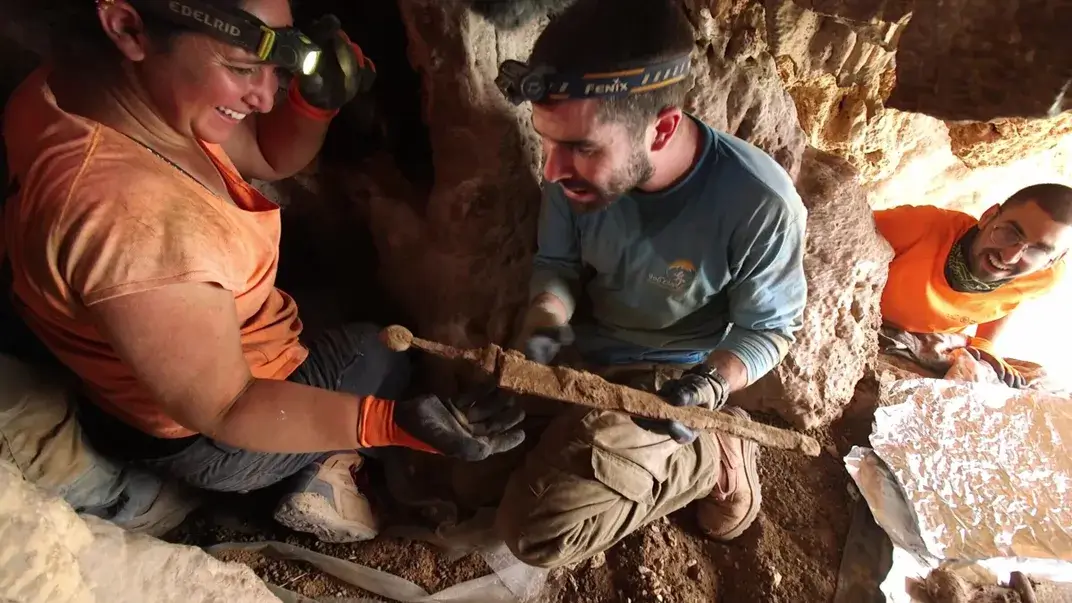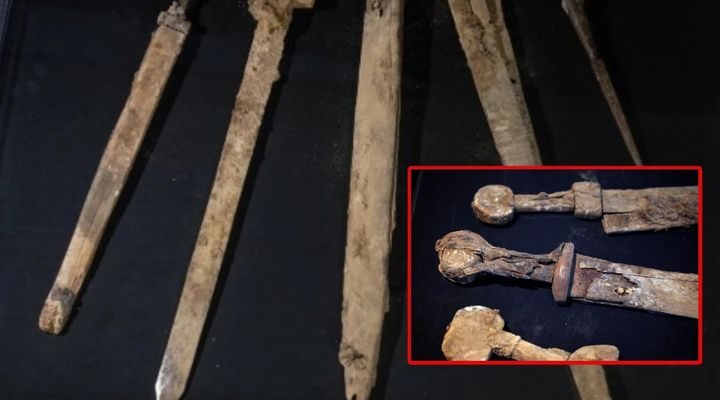Archaeologists in Israel have discovered four Roman-Era swords in a cave near the Dead Sea.

Even at roughly 1,900 years old, the artefacts are “exceptionally well preserved,” according to a statement from the Israel Antiquities Authority (IAA), which announced the find earlier this week.
The swords have wooden and leather hilts, and their steel blades are all between 60 and 65 centimetres (24 and 26 inches) long.
The researchers haven’t yet carbon-dated the weapons—or the head of a javelin (known as a pilum) found alongside them—but they think the artefacts came from a Jewish uprising against the Romans in the 130s C.E.
Archaeologists Discover 3,000-Year-Old Sword In Germany So Well Preserved ‘It Almost Still Shines’
They published their preliminary findings in a new book, New Studies in the Archaeology of the Judean Desert: Collected Papers.
“This is a dramatic and exciting discovery, touching on a specific moment in time,” says Eli Escusido, director of the IAA, in a statement. “Not all are aware that the dry climatic conditions … in the Judean Desert enable the preservation of artefacts that do not survive in other parts of the country.”

Archaeologists remove the Roman-era swords from the Israeli cave. Emil Aladjem / Israel Antiquities Authority
The items probably weren’t made locally, as Guy Stiebel an archaeologist at Tel Aviv University specializing in Roman military history, tells Ilan Ben Zion of the Associated Press (AP).
Instead, they were likely forged in a faraway European province, traveling vast distances alongside their owners.
“Each one of them can tell you an entire story,” Stiebel tells the AP. “They also reflect a much grander narrative of the entire Roman Empire.” The fact that “a small cave in a very remote place on the edge of the empire” can shed light on that narrative “is the greatest joy that the scientist can have,” he adds.
Researchers hypothesize that Jewish rebels seized the swords from the Roman army and hid them in the cave during the Bar Kokhba revolt, a Jewish rebellion against the Roman Empire that took place between 132 and 135 C.E.
It was ultimately unsuccessful; the Jews suffered heavy losses, and in the revolt’s aftermath, they were subject to severe persecution.

“Obviously, the rebels did not want to be caught by the Roman authorities carrying these weapons,” says Eitan Klein, one of the directors of the Judean Desert Survey Project, in the IAA’s statement. “We are just beginning the research on the cave and the weapon cache discovered in it, aiming to try to find out who owned the swords, and where, when and by whom they were manufactured.”
The researchers stumbled upon the swords by chance. They had come to the cave to photograph a stalactite with an ink inscription in ancient Hebrew found 50 years ago, according to Jennifer Nalewicki of Live Science.
When they unearthed the swords, they couldn’t believe their good fortune.
“Finding a single sword is rare—so four?” say the researchers in the IAA’s statement. “It’s a dream! We rubbed our eyes to believe it.”
The sword of Joyeuse, which today sits in the Louvre Museum, is one of the most famous swords in history. Historical records link the sword to Charlemagne the Great, King of the Franks.
If it did indeed belong to the famous king, who reigned some 1,200 years ago, the sword of Joyeuse would have been used in countless coronation ceremonies, and is tied with ancient myth and legend ascribing it with magical powers.
The story begins in the year 802 AD. Legend states that the sword of Joyeuse, meaning “joyful” in French, was forged by the famous blacksmith Galas, and took three years to complete. The sword was described as having magical powers associated with it. It was said to have been so bright that it could outshine the sun and blind its wielder’s enemies in battle, and any person who wielded the legendary sword could not be poisoned. The Emperor Charlemagne, coming back from Spain was said to have set up camp in the region and acquired the sword.



